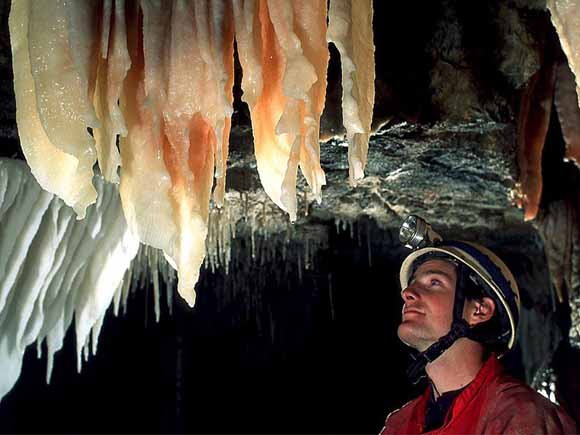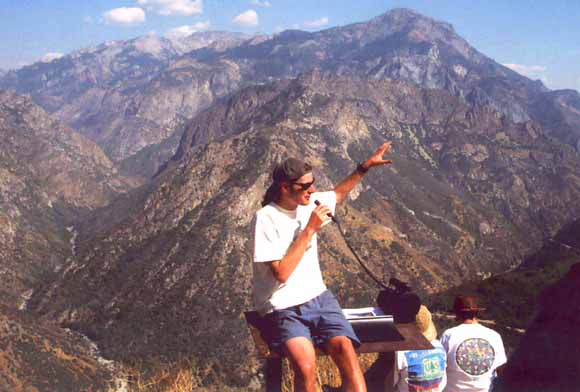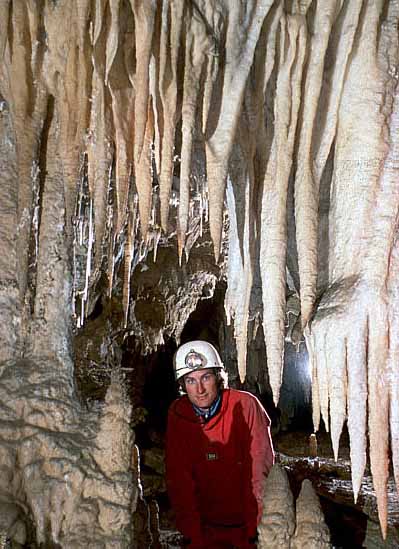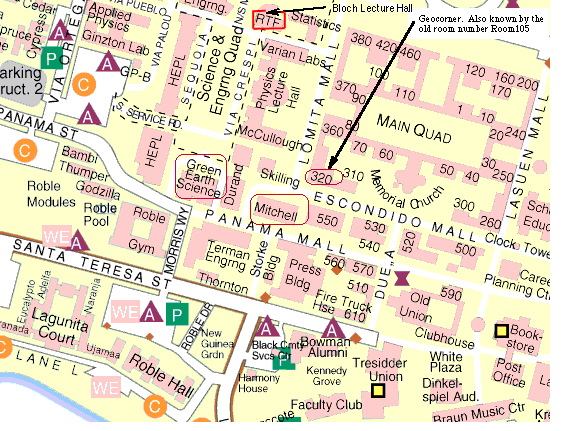see Map showing Mitchell
Map showing Bloch
Anyone wishing to attend the lecture only is welcome at no cost.
This will be the 357th meeting since 1954.

Greg Stock
Abstract
(From a paper by Greg M. Stock, Robert S. Anderson, and Robert C. Finkel)The late Cenozoic history of the Sierra Nevada continues to be an area of active geological research, with considerable debate regarding whether or not the range experienced uplift in the last 10 Myr. We approach the problem from a geomorphic perspective, using the unique archives of caves and cave deposits to determine new rates of river incision. In the Sierra Nevada, numerous caves adorn the walls of deep canyons cut into marble bedrock. These caves represent former river levels etched into the bedrock. Using 26Al/10Be ratios, we determine burial ages for granitic bedload sediments washed into caves once at river level and now perched high in canyon walls. We find that rapid incision of ~0.2 mm yr-1 from 2.7 to ~1.5 Ma slowed markedly to ~0.02 mm yr-1 thereafter. Numerical modeling of river profile evolution indicates that the reduction in incision rate is likely due to a transient response to Pliocene rock uplift. Westward tilting sufficient to drive the proposed 1.5 - 2 km of crestal uplift initiates a pulse of accelerated erosion that begins at the edge of the Central Valley and propagates up the river profile, passing the caves between ~5 and 2 Ma. Incision rates decline markedly after this time. Late Quaternary incision may be further reduced by periodic mantling of riverbeds with glacially derived sediment. The caves demonstrate that while ~400 m of incision has occurred in the last 2.7 Myr, canyons up to 1.6 km deep existed prior to that time. In addition, 26Al and 10Be concentrations on granitic interfluve surfaces indicate that these surfaces are eroding at ~0.012 mm yr-1 averaged over ~70 kyr. This is more than an order of magnitude slower than late Pliocene and early Quaternary incision rates, and 2 to 3 times slower than late Quaternary incision rates. As slow interfluve erosion likely persisted throughout the Quaternary, local relief increased during the period of rapid incision. Our findings of substantial pre-Quaternary canyon relief and slow interfluve erosion serve to lessen the amount of flexural isostatic rock uplift expected due to late Cenozoic erosion, strengthening the case for tectonically-driven late Cenozoic uplift.
About the Speaker

Greg on a Friends of the Pleistocene field trip
Greg Stock grew up in the Sierra Nevada foothills near the Stanislaus River, and spent most of his teenage years exploring caves in the area. He received a Bachelor of Science degree in Geology from Humboldt State University in 1997, and subsequently worked seasonally for the National Park Service in Sequoia-Kings Canyon National Parks mapping caves. During the winter seasons he mapped lava tubes in Hawai‘i Volcanoes National Park. In 1999 Greg started graduate work at UC Santa Cruz under the advisement of Robert Anderson and James Zachos, and is presently a Ph.D. candidate studying the tectonic and climatic implications of dated cave deposits in the Sierra Nevada.

Reservations: The preferred way to make reservations is simply to email Janice Sellers at janice@seismosoc.org by Friday, November 7, tell her you will attend, commit to pay, and bring your payment to the meeting. Janice always emails a confirmation; if you don't get one, assume email crashed yet again and email her a second time. A check made to"PGS"is preferred, payable at the meeting.
If you want to pay in advance:
Stanford faculty and students: Please make dinner reservations by Friday, November 7. Contact Dr. Juhn Liou via his mailbox (and leave check), Geological and Environmental Sciences Office, Geocorner - Bldg. 320 (Rm. 118). Make checks out to"PGS."
All others, including faculty and students from other Bay Area universities and colleges and USGS: Please make dinner reservations by Friday, November 7. Contact Janice Sellers, at Seismological Society of America, 201 Plaza Professional Building, El Cerrito, CA 94530, phone (510) 559-1780. Send check made out to"PGS"to Janice.
Dinner is $30.00. Includes wine (5:30 to 6:15 PM.), dinner (6:15-7:30 PM.), tax, and tip.
For students. We are sorry to report that our funding for helping to pay for student dinners has dried up. We may be able to hustle some help in the future. For now, we all have to pay full price.
Dues for Academic Year 2003-2004 ($10.00) should be sent to Janice Sellers, Seismological Society of America, 201 Plaza Professional Building, El Cerrito, CA 94530. Janice's phone: (510) 559-1780.
Officers: Cheryl Smith, President; Mike Diggles, Vice President; Vicki Langenheim, Secretary; Janice Sellers, Treasurer; Adina Paytan, Field-Trip Czarina

Click Here for Future Events
Date created: 10/31/2003
Last modified: 11/12/2003
Created by: Mike Diggles, Vice President, PGS.
c/o U.S. Geological Survey, MS-951, 345 Middlefield Road, Menlo Park, CA 94025. (650) 329-5404. email Mike Diggles at mdiggles@usgs.gov
